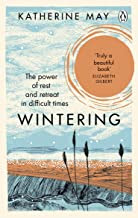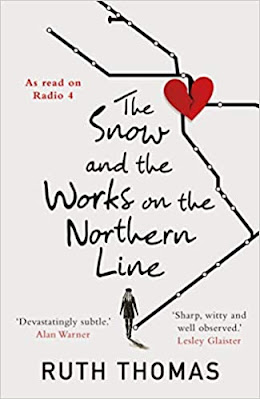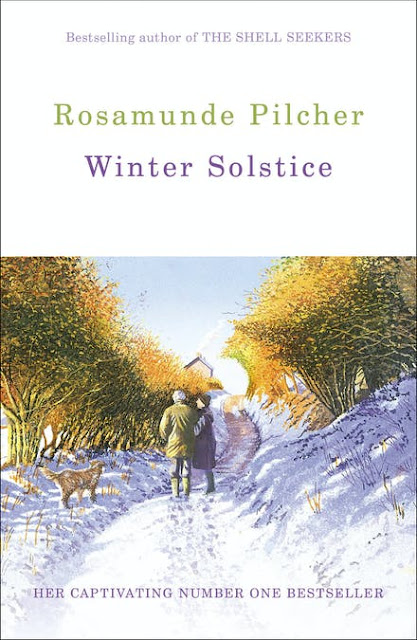Six Degrees of Separation: July 2022
Six degrees of Separation is hosted
by Kate of http://booksaremyfavouriteandbest.com.
The starter book this month is Wintering by Katherine May.
I have to say this book sounds like it would irritate me beyond measure. As I’ve not actually read it, I won’t say any more, but will instead move swiftly on to my first link, The Snow and the Works on the Northern Line by Ruth Thomas. The obvious connection is winter, but from what I have read about Wintering, a second link is the way in which someone deals with unhappiness.
The Snow and the Works on the Northern Line was beautifully read by Ell Potter
on Radio 4 last year. I loved it then, and having now just read the paper
version I love it even more. It’s about Sybil, who works at the Institute for
Prehistorical Studies in Greenwich and lives with her chef boyfriend Simon.
Everything is going well enough until two things happen. Sybil has an accident
resulting in a head injury at the skating rink (somewhere she only went to
please Simon), and Helen Hansen walks back into Sybil’s life.
As Sybil’s former university tutor, Helen tried
(unsuccessfully) to have her dissertation, and thus her class of degree, marked
down. Helen is now the director of the London Museums Interpretation Centre,
which has been set up to forge links between academic organisations and
commerce – in other words, to generate some income for these cash-strapped
places by producing ‘merchandise’ and turning half their floor space into gift
shops. She is glamorous, self-assured and patronising. In fact she is
everything that Sybil isn’t.
Helen has also garnered great acclaim for some
ground-breaking research into the Beaker People (coincidentally – or is it? –
the subject of Sybil’s dissertation). Before long she is on the board of
trustees at the Institute. And even before that, she has stolen Simon from
Sybil.
Sybil’s utter devastation at Helen and Simon’s betrayal soon becomes obsessive.
She hates the ghastly Helen for so many reasons, and in her own quiet way she
is determined to have her revenge.
Ruth Thomas leads us through Sybil’s miserable, lonely winter in London. Unlike
Katherine May she can’t escape; she still has to go to work every day and put
up with Helen, she still has to live somewhere (so ends up in a flatshare with
the annoying Esther), she still has to listen to her mother trying, in the ways
mothers do, (and I am one!) to cheer her up with things like a book entitled
‘When Life Gives You Lemons…’
There are so many subtleties in this wonderful novel, and so many well drawn
characters. And perhaps surprisingly there are also so many moments of humour –
these, I think, work better on the page than in the audio version. Above all, I
could identify with Sybil, just as I could recognise the various oddballs she
comes across along the way (at the Institute, the library, the poetry group,
the hairdresser’s…). This is a completely convincing story of how someone deals
with grief (Sybil’s also just recently lost her beloved grandfather) and how
they eventually start to emerge from the depths of misery. And Sybil’s revenge
on Helen, when she finally gets it, is brilliant.
My next link is to Meet Me At the Museum by Anne Youngson, and the connection is ancient artefacts, although it could just as well be loneliness and isolation. 60-something Suffolk farmer’s wife Tina Hopgood writes a letter to Professor Glob at the Silkeborg Museum in Denmark. She wants to enquire about the Iron Age Tollund Man. She and her best friend at school, Bella, had always promised themselves that they would go to Denmark to see this perfectly preserved corpse, but the years have passed, Bella is no longer alive, and Tina doesn’t know if she wants to see it or not.
It transpires that Professor Glob is dead, but the current curator, Anders Larsen, replies. There follows an initially formal but soon much more relaxed exchange of letters between these two very different people. They talk about their lives, their children, their thoughts and hopes; they become friends, with the suggestion that their friendship may develop into something more.
Meet Me at the Museum is another quiet, unusual and moving novel, the kind I like best, and I enjoyed it very much.
Anne Youngson was over 70 when Meet Me at The Museum was published. (She had previously had a long and successful career in the motor industry.) Another author who started late was Mary Wesley; her first book for adults Jumping the Queue appeared in 1983 when she was 71; in the last twenty years of her life she wrote ten best sellers (she died at the age of 90.)
Most of Wesley’s books are based, at least in part, on her aristocratic
and difficult family and her own adventurous and unconventional life (there’s a
reason why her authorised biography, written when she was bedridden and dying,
is called Wild Mary*.) My favourite of her novels is The Camomile
Lawn, which is set in Cornwall and London, and is the story of the
members of three interlinked families, mostly during the Second World War but
with a final reunion 50 years later. The book was adapted for television in
1993 and the DVD is still well worth watching.
Another family saga that encompasses the second world war is Elizabeth Jane Howard’s
Cazelet Chronicles of which the first book is The Light Years.
Three generations of the Cazalet family are followed from 1937 onwards; births,
illnesses, deaths, marriages, divorces, pregnancies, affairs, incest – it’s all
there, but the books are almost as engaging for the details of domestic and
marital (very upper middle class) life in the early/mid twentieth century. Sybil
going up to London to buy Chilprufe vests for the little ones; Villy having all
of her teeth removed as a kind of fortieth birthday present (apparently this was
quite usual! I suppose it saved on dentist’s fees…); the Duchy (the senior matriarch’s
nickname, from which one can infer that she is old school posh) sitting down
with the cook every morning to discuss the menus – ‘And salmon, I think,
Mrs Briggs’ – which, of course, translates not as ‘that’s one idea, what do you
think?’ but ‘salmon is what I want, no arguments.’ It’s posh talk…
Elizabeth Jane Howard based these books on her own upbringing and experiences.
They are an absolute joy to read, and I am quite jealous of anyone coming to
them for the first time.
There are three sons and one daughter in the second generation of Cazalets, and
it is Rachel Cazalet who provides my next link. Rachel is conducting a clandestine
affair with ‘Sid’ – Margot Sidney, a half Jewish music teacher who wants Rachel
to stop being such a martyr to her parents, the house, etc, and move in with
her. Rachel loves Sid but is torn between duty and personal satisfaction.
In Joanna Trollope’s A Village Affair, Alice Jordan moves, with her
affluent, reliable, husband and their small children, to a beautiful house in a
chocolate box village (though far too near to her dominating mother-in-law.)
Alice is depressed after the birth of her last baby. She knows she has
everything she could possibly want, but she can’t find a meaning in life until
she meets Clodagh, the wild and wayward daughter of the local nobility. Clodagh
becomes a fixture in Jordan domestic life. The children love her - and so, very
soon, does Alice. When the two women embark on an affair Alice is reinvigorated
and happy – but very few people share their happiness. The villagers are scandalised,
her mother-in-law is furious, and her husband (even though he has also made a
pass at Clodagh – but that’s OK because he is after all a man) is devastated.
I don’t find Clodagh a very appealing character – she is bossy, entitled and irresponsible – but the way in which her affection liberates Alice is exhilarating. It is quite a shock to realise that this novel was published in 1989, ie just 33 years ago, yet the disapproval, prejudice – and fundamentally the homophobia - sparked by Alice and Clodagh’s relationship seem quite alien to us today. Thank goodness.
Village life is the connection to my final book.
Miss Read (Dora Saint) wrote many books about two fictional rural villages,
Fairacre and Thrush Green. Although they are often dismissed as ‘cosy’, they do in fact address many quite serious issues, and they remain very popular today.
In Winter in Thrush Green (the second in the series, first
published in 1961) a new resident moves into the village, the headmistress of
the school is robbed and assaulted, and a widow is on the hunt for a new
husband.
So for once I have managed to come full circle and return to winter.
Next month’s 6 Degrees will start with The Book of Form and Emptiness by
Ruth Ozeki.
*Wild Mary by Patrick Barnham, published by Chatto and Windus in 2006









YEAH for coming full circle!
ReplyDeleteBoth the museum titles appeal to me. And the rest, unusually, I've read - and, as far as I remember, enjoyed.
ReplyDeleteThis is a great assortment! I read and enjoyed Youngson's other book (I found Meet Me at the Museum confusing on audio so I returned it and need to get the print version). I liked the middle three but have not read Miss Read. My mother has just reread all the Cazalet books which made me wonder if I read all or just the first two. I need to check.
ReplyDelete